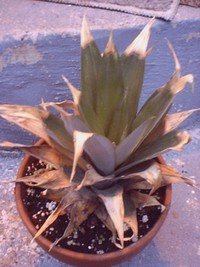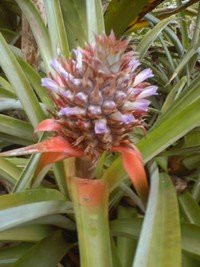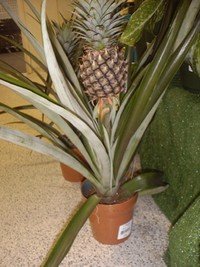Don't throw out that pineapple fruit top! Enjoy a bit of the tropics by growing your own pineapple fruit plant.
(Editor's Note: This article was originally published on October 8, 2007. Your comments are welcome, but please be aware that authors of previously published articles may not be able to promptly respond to new questions or comments.) There are some of you, I am certain, that started gardening at a toddler‘s age, as did I, in the kitchen. My Mom introduced me to growing plants by occasionally providing me pared off bits of vegetables while she prepared dinner. To my tiny hands and immense imagination, a carrot top placed in a saucer of water would magically grow into an emerald forest. A sweet potato segment held by toothpicks at the mouth of a Mason jar would create a jungle liana to sprawl across the windowsill. Learning that garbage could be transformed into greenery created wonderment and a love for gardening. It also left me with an urge to nurture every scrap of vegetable matter that has any chance of survival.
I can’t imagine throwing away the green top off a pineapple fruit without making some attempt to grow it. In fact, I seldom buy a fresh whole pineapple for any reason other than to usurp the vegetative crown. The gastronomic enjoyment of the pineapple is just an obligatory step toward rescuing the bromeliad that has silently screamed to me from the grocery produce shelf, pleading for a second chance at life.
Fortunately, I live in a hot, humid climate that is suitable for pursuing a personal pineapple plantation. Though the Ananas comosus is rated for areas more tropical than my Zone 8b/9a half-acre, I have found that, despite claims to the contrary, the pineapple can survive frosts and light freezes (as low as 28 F on a few nights) without fatal damage.
There are meticulous directions for pineapple growing to be found at several Internet sites. If you are most comfortable when you have step-by-step procedures, then you should follow the guidelines provided there. I pursue a more simple, relaxed approach in growing pineapples, as I do with most things, and I can produce a viable pineapple plant with limited stress, time, and energy.

I begin by reassuring the pineapple that I have only good intentions for it, then I provide a swift, assertive surgical slice about half an inch below the base of the rosette. I have, in the past, just plopped this cut end into potting soil and let it grow with good results. There will be some initial drying out and browning of the larger leaf tips, but don’t despair. As long as the small center leaves remain green and stiff, your pineapple will likely grow. If not, buy another pineapple and start again.
Though many of the online directions are, I think, unnecessary (and sometimes contradictory), paring away the excess fruit down to the center core to prevent fungal rot is probably a good idea. I also now peel off the bottom whirl of smallest leaves to expose and encourage growth from the tiny brown root buds. Other than that, I don't do any preparation of my pineapple crown before putting it in soil. The photo above shows my latest pineapple, already firmly rooted after only a few weeks.
A potting soil with plenty of sand added for good drainage will make an appropriate roost for your pineapple. Keep the soil moist without being soggy -- dry is better than wet -- and apply half-strength fertilizer once or twice a month.
Pineapple plants and other epiphytes have the ability to absorb water and nutrients through their roots and also through their leaves by layered gray scales known as “trichomes.” The “tank" or "cup” structure that retains water and dissolved organic matter for uptake in the center of many bromeliads is generally lacking in the more open array of pineapple plant leaves.
Like most bromeliads, the pineapple plant can be expected to die soon after flowering. In addition to the bromeliad crown atop the fruit, the mature pineapple plant may produce new plants as slips and shoots on the stem and at leaf axils, and suckers and ratoons at or below soil level.
Have you ever wondered where the seeds are in a pineapple fruit? The pineapple is an example of a parthenocarpic (literally, “virgin fruit”) plant that does not require pollination of the flower to produce fruit. Each bump on the outside of a pineapple is the remnant of a flower bract. If the small purple flowers that once sat in these bracts were pollinated, each of the bumps would have a black seed just below the thick pineapple skin. On rare occasions, you might find a grocery store pineapple with a seed, but growers have genetically bred pineapples to further enhance their natural tendency toward being seedless. The pineapple is also a compound fruit consisting of dozens of individual fruits, represented by the bumps on the skin, that are fused around the center stem.
Regardless of your zone, you may be able to grow a pineapple if you have a sunny patio or terrace for outdoor summer growth, and an indoor window with bright light for the wintertime. The pineapples planted in my yard get a few hours of direct sun, but they mostly have diffuse light provided by towering oaks and the canopy of a Giant Crinum Lily. You can increase the ambient humidity around your pineapple when it is indoors by placing it above a tray of moist gravel, providing frequent misting with very dilute liquid fertilizer, and using a humidifier during periods of indoor winter heat.
All my pineapple plants get stuck into the yard as soon as they are rooted. They flower and fruit in their own time. Online sources seem to insist that potted pineapples must be forced into flower by the introduction of ethylene gas or hormones. I think, however, if you provide enough sunlight and correct watering and feeding, your pineapple in a pot will come to fruition.

The pineapple is not a very showy plant when it is not in the fruiting stage. In most situations, it will reach a mature size of about twenty-four inches high and wide. It will then sit like a gray-green spiny spider for about two to three years without much further growth. It is worth the wait, however, when seemingly overnight, the center leaves blush with a bright red fiery glow, and a flower stalk and fruit begin to emerge! It may take four to six months for the fruit to fully ripen. Your pineapple is certain to be a conversation piece during that time. Don't eat the fruit while it is green! -- It can be poisonous and result in mouth and throat irritation along with "extreme purging." Once the pineapple reaches a golden yellow, you can delight in the delicacy of your own homegrown fruit, which all accounts report to be the tastiest pineapple ever. You may then start the cycle over again with the cut off bromeliad crown and pass your subsequent pineapple clones down through the generations as you would any treasured family heirloom.


Here is a commercially "forced" pineapple in a six inch plastic pot for the florist trade available at a local grocery store for $15.95. But what fun is that? Grow your own!
Have you had successes or failures, or are you currently growing a pineapple plant? You are invited to post your comments, questions, and photos below.






 I begin by reassuring the pineapple that I have only good intentions for it, then I provide a swift, assertive surgical slice about half an inch below the base of the rosette. I have, in the past, just plopped this cut end into potting soil and let it grow with good results. There will be some initial drying out and browning of the larger leaf tips, but don’t despair. As long as the small center leaves remain green and stiff, your pineapple will likely grow. If not, buy another pineapple and start again.
I begin by reassuring the pineapple that I have only good intentions for it, then I provide a swift, assertive surgical slice about half an inch below the base of the rosette. I have, in the past, just plopped this cut end into potting soil and let it grow with good results. There will be some initial drying out and browning of the larger leaf tips, but don’t despair. As long as the small center leaves remain green and stiff, your pineapple will likely grow. If not, buy another pineapple and start again. The pineapple is not a very showy plant when it is not in the fruiting stage. In most situations, it will reach a mature size of about twenty-four inches high and wide. It will then sit like a gray-green spiny spider for about two to three years without much further growth. It is worth the wait, however, when seemingly overnight, the center leaves blush with a bright red fiery glow, and a flower stalk and fruit begin to emerge! It may take four to six months for the fruit to fully ripen. Your pineapple is certain to be a conversation piece during that time. Don't eat the fruit while it is green! -- It can be poisonous and result in mouth and throat irritation along with "extreme purging." Once the pineapple reaches a golden yellow, you can delight in the delicacy of your own homegrown fruit, which all accounts report to be the tastiest pineapple ever. You may then start the cycle over again with the cut off bromeliad crown and pass your subsequent pineapple clones down through the generations as you would any treasured family heirloom.
The pineapple is not a very showy plant when it is not in the fruiting stage. In most situations, it will reach a mature size of about twenty-four inches high and wide. It will then sit like a gray-green spiny spider for about two to three years without much further growth. It is worth the wait, however, when seemingly overnight, the center leaves blush with a bright red fiery glow, and a flower stalk and fruit begin to emerge! It may take four to six months for the fruit to fully ripen. Your pineapple is certain to be a conversation piece during that time. Don't eat the fruit while it is green! -- It can be poisonous and result in mouth and throat irritation along with "extreme purging." Once the pineapple reaches a golden yellow, you can delight in the delicacy of your own homegrown fruit, which all accounts report to be the tastiest pineapple ever. You may then start the cycle over again with the cut off bromeliad crown and pass your subsequent pineapple clones down through the generations as you would any treasured family heirloom.
 Here is a commercially "forced" pineapple in a six inch plastic pot for the florist trade available at a local grocery store for $15.95. But what fun is that? Grow your own!
Here is a commercially "forced" pineapple in a six inch plastic pot for the florist trade available at a local grocery store for $15.95. But what fun is that? Grow your own!